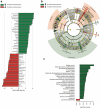Characterization of gut microbiota composition and functions in patients with chronic alcohol overconsumption
- PMID: 30894059
- PMCID: PMC6866679
- DOI: 10.1080/19490976.2019.1580097
Characterization of gut microbiota composition and functions in patients with chronic alcohol overconsumption
Abstract
Excessive alcohol intake can alter the gut microbiota, which may underlie the pathophysiology of alcohol-related diseases. We examined gut microbiota composition and functions in patients with alcohol overconsumption for >10 years, compared to a control group of patients with a history of no or low alcohol intake. Faecal microbiota composition was assessed by 16S rRNA sequencing. Gut microbiota functions were evaluated by quantification of short-chain fatty acids (SCFAs) and predictive metagenome profiling (PICRUSt). Twenty-four patients, mean age 64.8 years (19 males), with alcohol overconsumption, and 18 control patients, mean age 58.2 years (14 males) were included. The two groups were comparable regarding basic clinical variables. Nutritional assessment revealed lower total score on the screening tool Mini Nutritional Assessment, lower muscle mass as assessed by handgrip strength, and lower plasma vitamin C levels in the alcohol overconsumption group. Bacteria from phylum Proteobacteria were found in higher relative abundance, while bacteria from genus Faecalibacterium were found in lower relative abundance in the group of alcohol overconsumers. The group also had higher levels of the genera Sutterella, Holdemania and Clostridium, and lower concentration and percentage of butyric acid. When applying PICRUSt to predict the metagenomic composition, we found that genes related to invasion of epithelial cells were more common in the group of alcohol overconsumers. We conclude that gut microbiota composition and functions in patients with alcohol overconsumption differ from patients with low consumption of alcohol, and seem to be skewed into a putative pro-inflammatory direction.
Keywords: Clostridium; Faecalibacterium; Holdemania; Nutritional screening; PICRUSt; Proteobacteria; Sutterella; short-chain fatty acids.
Figures




Similar articles
-
Short-chain fatty acids accompanying changes in the gut microbiome contribute to the development of hypertension in patients with preeclampsia.Clin Sci (Lond). 2020 Jan 31;134(2):289-302. doi: 10.1042/CS20191253. Clin Sci (Lond). 2020. PMID: 31961431
-
Plasma cytokine levels in patients with chronic alcohol overconsumption: Relations to gut microbiota markers and clinical correlates.Alcohol. 2020 Jun;85:35-40. doi: 10.1016/j.alcohol.2019.10.002. Epub 2019 Oct 11. Alcohol. 2020. PMID: 31610228
-
Comparison of Microbial Diversity and Composition in Jejunum and Colon of the Alcohol-dependent Rats.J Microbiol Biotechnol. 2018 Nov 28;28(11):1883-1895. doi: 10.4014/jmb.1806.06050. J Microbiol Biotechnol. 2018. PMID: 30270610
-
Changes in the composition of the human intestinal microbiome in alcohol use disorder: a systematic review.Am J Drug Alcohol Abuse. 2020;46(1):4-12. doi: 10.1080/00952990.2019.1669629. Epub 2019 Nov 5. Am J Drug Alcohol Abuse. 2020. PMID: 31689142
-
Characterizing the Composition of the Pediatric Gut Microbiome: A Systematic Review.Nutrients. 2019 Dec 19;12(1):16. doi: 10.3390/nu12010016. Nutrients. 2019. PMID: 31861722 Free PMC article.
Cited by
-
Gut Microbiota, Muscle Mass and Function in Aging: A Focus on Physical Frailty and Sarcopenia.Nutrients. 2019 Jul 17;11(7):1633. doi: 10.3390/nu11071633. Nutrients. 2019. PMID: 31319564 Free PMC article. Review.
-
Gut-muscle crosstalk. A perspective on influence of microbes on muscle function.Front Med (Lausanne). 2023 Jan 9;9:1065365. doi: 10.3389/fmed.2022.1065365. eCollection 2022. Front Med (Lausanne). 2023. PMID: 36698827 Free PMC article.
-
Gut microbiota dysbiosis: The potential mechanisms by which alcohol disrupts gut and brain functions.Front Microbiol. 2022 Jul 29;13:916765. doi: 10.3389/fmicb.2022.916765. eCollection 2022. Front Microbiol. 2022. PMID: 35966709 Free PMC article. Review.
-
Alcohol decreases intestinal ratio of Lactobacillus to Enterobacteriaceae and induces hepatic immune tolerance in a murine model of DSS-colitis.Gut Microbes. 2020 Nov 9;12(1):1-16. doi: 10.1080/19490976.2020.1838236. Gut Microbes. 2020. PMID: 33180663 Free PMC article.
-
Effects of alcohol on the composition and metabolism of the intestinal microbiota among people with HIV: A cross-sectional study.Alcohol. 2024 Nov;120:151-159. doi: 10.1016/j.alcohol.2024.02.003. Epub 2024 Feb 20. Alcohol. 2024. PMID: 38387693 Free PMC article.
References
-
- WHO Global status report on alcohol and health. World Health Organ. 2014;1:1–392.
-
- Tsuruya A, Kuwahara A, Saito Y, Yamaguchi H, Tsubo T, Suga S, Inai M, Aoki Y, Takahashi S, Tsutsumi E, et al. Ecophysiological consequences of alcoholism on human gut microbiota: implications for ethanol-related pathogenesis of colon cancer. Sci Rep. 2016;6:27923. doi:10.1038/srep27923. - DOI - PMC - PubMed
Publication types
MeSH terms
Substances
LinkOut - more resources
Full Text Sources
Medical
